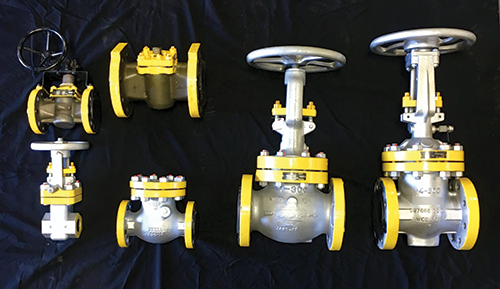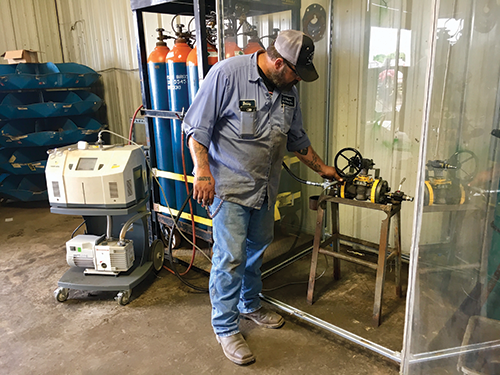Hydrofluoric (HF) acid: just the name itself strikes fear in some people, even among those who work around it every day.
Two places where this substance is commonly used are refinery and chemical plants where HF acid, and the valves that handle it, are usually segregated from the rest of the refinery by a large painted curb. The unit operators that run the unit and maintain the valves are easy to recognize: They’re the ones donning face shields, rubber jackets, pants and gloves, along with a sticker to show that they’ve had the extra training necessary to step past that curb. Their caution is absolutely necessary—HF acid is extremely hazardous. That’s why most refineries take maximum measures to ensure the safety of their employees and their surroundings and protect the equipment that must handle this scary stuff. That’s also why handling these valves requires following strict guidelines.
HF ACID IN REFINING
Refiners use large volumes of highly concentrated HF acid or sulfuric acid as chemical catalysts in a process called alkylation. Alkylation creates additives that boost the octane of gasoline.
Several benefits to using HF make it more attractive than sulfuric acid. First, the typical HF alkylation unit requires far less acid than a sulfuric acid unit to achieve the same volume of alkylate. Second, the HF process only creates a small amount of organofluoride side products. These side products are continuously removed from the reactor and the consumed HF is easily replenished. Third, HF alkylation units are capable of processing a wider range of light-end feedstocks with propylene and butylene. They also produce alkylate with a higher-octane rating than sulfuric plants. However, because of its hazardous nature, HF acid is produced at very few locations and transportation is stringently managed and regulated.
A BRIEF HISTORY
On Dec. 25, 1942, the first-ever commercial HF acid alkylation unit (HFAU) began production at the Borger Refinery of the Phillips Petroleum Company. The United States’ entry into WWII created an urgent national requirement for expanded aviation gasoline production, which sparked a meeting that was sponsored by Phillips at Amarillo and Borger, TX. The purpose of the meeting was to present the full details of the design and operation of this new process to the petroleum industry at large. It was widely attended by refiners and engineering contractors and resulted in numerous requests that the industry be kept advised of developments on corrosion rates, mechanical problems and similar considerations. These findings were released as they became available, and the attendant process policies became known as blue books (because of their blue covers). These process policies eventually became the Phillips Licensing Specification. The two major licensors of the HFAU process were UOP and Conoco Phillips, which at the time, held similar shares of the market. The two have since been combined as UOP under the ownership of Honeywell. While most refiners operate under the UOP umbrella, plants are still referred to as legacy “Phillips” or legacy “UOP” operating facilities. Today, about 50 U.S. oil refineries use HF acid.
MATERIALS AND TYPES OF VALVES
Most refiners refer to the current UOP specifications as a guideline to determine what valves they can put into an HF unit area. UOP offers options based on valve type, size, manufacturer and service conditions. Readers of the specs have to be vigilant because the options may seem inconsistent. For example, a manufacturer may be approved for a 1-inch, 800-pound socket weld gate valve, but that same manufacturer may not be approved for a 2-inch, 300-pound flanged gate valve.
Monel 400 and 500 are still the most popular materials used in HF acid service. Instead of traditional B7 or B16 bolting, HF acid valves require B7M bolting, which is heat treated. The treatment makes the bolting softer, which makes it more resistant to cracking when exposed to HF acid. While Monel spiral-wound gaskets are still the most common gasket used, the use of Kammprofile gaskets has steadily increased in popularity, especially in the HF alky market. Kammprofile gaskets maintain stability in high-temperature and high-pressure applications, and they offer a flexible and highly reliable seal.
Gate, globe, check, control and relief valves typically have carbon steel bodies with Monel internals, including but not limited to stem, disc, seat, backseat and packing pusher. Trim packages typically depend on the atmosphere and the concentration of HF acid. UOP uses terms such as HF-1, HF-2, etc. While carbon steel bodies with Monel internals are a common trim package, for areas running higher-concentrated to full-strength HF, solid Monel valves are most often recommended.
Some gate and globe valve manufacturers have started implementing the bellows seal design between the stem and the stuffing box area. This serves as an added layer of protection to help reduce any leak detection and repair issues that can arise from the packing areas.
Sleeve-lined plug valves are generally the most common block (isolation) valve used in HF systems today. Although many manufacturers have proprietary designs, the general design is the same: A Teflon liner is installed in a valve body. A tapered plug is then installed to fit between the sleeve and the body, creating the passageway seal. Most sleeve-lined plug valves must be factory-tooled, and technicians must be specially trained to install the liners into the valve bodies, which is why using factory-authorized service centers is critical. Construction is complete after the top cap and diaphragm are installed on the valve.
Most customers in the petrochemical industry require new plug valves to pass their own stringent set of criteria, known as their recommended practices (RP) plan, to be allowed in their refineries. Supplying a valve that adheres to the customer’s RP plan is crucial to ensure that the valve meets all the criteria established by the end user.
Check valves use the API [American Petroleum Institute] RP 600 construction criteria. This allows for check valves with both external and internal hinge pins. Most refiners are starting to lean toward an internal hinge pin design to eliminate the extra leak path created by hinge pin plugs of legacy designs.
REPAIR AND TESTING
API RP 621 lays out a foundational protocol focused on the repair of valves. It covers most repair questions, including allowable wall thicknesses, stuffing box tolerances, stem tolerances and more. However, this RP is simply foundational; numerous HF repair end users require more intensive documentation during a repair. Most require positive material identification on all wetted parts that comprise the valve. Some even require the identification of the amount of residual elements that exist in the casting.
After repair of HF acid valves, most companies require that hydrostatic testing of the repaired valves be completed with a medium such as kerosene, diesel fuel or mineral oil. Water has a corrosive effect when it comes in contact with HF acid, so its use is not recommended. In addition to a hydrostatic test, some companies take the additional precaution of requiring a helium test, which uses a mass spectrometer to interpret the volumetric leakage rates.
API RP 751
In 1992, the API released its API RP 751, which is the guideline to owners of HF units entitled Safe Operations of Hydrofluoric Acid Alkylation Units. This document provides valuable feedback to both valve manufacturers and remanufacturers alike and includes guidelines on bolting requirements, heat treatment requirements, fireproofing, testing frequency (for relief valves) and more.
Decontamination is one of the most important subjects discussed in API RF 751. This subject is especially important for transportation and for centers that receive valves for repair. The discussion on decontamination focuses on how to decontaminate valves before they can leave the unit boundaries. The processes are different for different types of valves and are not complicated. For instance, gate and globe valves should be opened with the bonnet bolting loosened, the packing should be removed, the body-to-bonnet connection should be broken to allow a neutralization solution to permeate the entire valve cavity.
Check valves should have the bonnet bolting, as well as any plugs, loosened during the decontamination process. Sleeve-lined plug valves should be open with the bonnet bolting loosened and the liner removed to ensure there is no trapped HF behind the valve liner. Most often, plugs are shipped independently of the valves to avoid scarring the plug during transportation. While API RP 751 does not give specific detail on how to properly decontaminate valves other than gate and globe valves, it does state that other areas where HF pockets may have accumulated should be disassembled. All neutralized equipment should have a tag affixed stating that the equipment has been in HF service and has been neutralized. While it is ultimately up to the unit owner how the valves are shipped, 751 does facilitate best practices pertaining to this matter.
CONCLUSION
HF acid is a hazardous and corrosive liquid. If accidentally released, it can form a vapor cloud. This presents serious health dangers to those who work with and around HF acid. However, proper design of alkylation units and strict adherence to best practices for maintenance, repair and proper decontamination techniques will help to protect the safety of refinery employees, repair shop technicians and the surrounding community.
MIKE DUNN is president of Refining and Pipeline Operations with J~S Machine and Valve Inc. (jsvalve.com). Reach him at mdunn@jsvalve.com.
RELATED CONTENT
-
Control Valves for Hydrogen Applications
Proper sizing, material selection and monitoring are as important as ever.
-
WCC and LCC Casting in ASME B16.34
Q: Why do WCC and LCC castings have different maximum allowable temperatures in ASME B16.34?
-
The Materials That Make Up Valves
EDITOR’S NOTE: Materials used in the manufacture of valves and how they perform in different applications is a topic of huge interest to everyone who works with valves.












 Unloading large gate valve.jpg;maxWidth=214)
